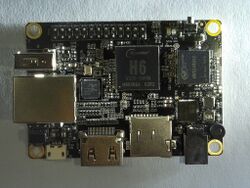Xunlong Orange Pi One Plus
| Xunlong Orange Pi One Plus | |
|---|---|
 | |
| Manufacturer | OrangePi |
| Dimensions | 68mm x 48mm |
| Release Date | December 2017 |
| Website | Device Product Page |
| Specifications | |
| SoC | H6 @ 1.8 Ghz |
| DRAM | 1GiB LPDDR3 @ xxxMHz |
| Power | DC 5V @ 2A (4.0mm/1.7mm barrel plug - centre positive), Micro USB (5V @ 2A) OTG power supply, or via GPIO header pins |
| Features | |
| Video | HDMI (Type 2.0A - full) |
| Audio | HDMI, on-board microphone |
| Network | 10/100/1000Mbps Ethernet (Realtek RTL8211) |
| Storage | µSD |
| USB | 1 USB2.0 Host, 1 USB2.0 OTG |
| Other | IRDA |
| Headers | UART, JTAG, LCD, VGA |
This page needs to be properly filled according to the New Device Howto and the New Device Page guide.
The Orange Pi One Plus is a 64-bit H6 based single board computer by Xunlong.
The Orange Pi One Plus is an upgrade from the previous Orange Pi One. It uses the new Allwinner H6 SoC. In comparison to Orange Pi One, this board has Quad Core Arm Cortex-A53 cpu. The SoC also has 4k capabilities at 60fps due to it's Mali T720 GPU.
In comparison to DDR3 RAM present in most SBCs, the One Plus uses 1GiB of LPDDR3 RAM. The board has 1 USB 2.0 port, Gigabit Ethernet, Pi Compatible GPIO header, OTG, etc.
The H6 support USB 3.0 but the board doesn't got it implemented. However, it's cousin, Orange Pi Lite 2 have one.
Identification
The One Plus has a black-colored pcb, different from it's older brother.
On the top of the device, the following is printed:
Orange Pi ONE PLUS
The PCB has the following silkscreened on it:
V2.0
Some boards have the following instead:
V3.0
In android, under Settings->About Tablet, you will find:
- Model Number: molly
- Build Number: petrel_fvd_p1-eng 7.0 NRD91N 20180110 test-keys
Sunxi support
Current status
Supported in both mainline U-Boot and Linux.
Manual build
You can build things for yourself by following our Manual build howto and by choosing from the configurations available below.
Mainline U-Boot
Use the orangepi_one_plus_defconfig (supported since v2018.09) build target.
Linux Kernel
Sunxi/Legacy Kernel
Use the orangepi_one_plus.fex file. This was extracted from the android sdcard image.
Mainline kernel
Use the sun50i-h6-orangepi-one-plus.dtb device-tree binary.
Expansion Port
The Orange Pi One Plus has a 26-pin, 0.1" connector with several low-speed interfaces. To learn about accessing the GPIO pins through sysfs with mainline kernel read GPIO
| 2x13 Header | |||
|---|---|---|---|
| 1 | 3.3V | 2 | 5V |
| 3 | PH06 (TWI1_SDA/SPI1_MISO/OWA_IN/PH_EINT6) | 4 | 5V |
| 5 | PH05 (TWI1_SCK/SPI1_MOSI/OWA_MCLK/PH_EINT5) | 6 | GND |
| 7 | PH04 (PWM1/SPI1_CLK/PH_EINT4) | 8 | PD21 (UART2_RTS) |
| 9 | GND | 10 | PD22 (PWM0/UART2_CTS) |
| 11 | PD24 (TWI2_SDA/UART3_RX) | 12 | PC09 |
| 13 | PD23 (TWI2_SCK/UART3_TX) | 14 | GND |
| 15 | PD26 (UART3_CTS) | 16 | PC08 |
| 17 | 3.3V | 18 | PC07 (SPI0_WP) |
| 19 | PC02 (SPI0_MOSI) | 20 | GND |
| 21 | PC03 (SPI0_MISO) | 22 | PD25 (UART3_RTS) |
| 23 | PC00 (SPI0_CLK) | 24 | PC05 (SPI0_CS0) |
| 25 | GND | 26 | PH03 (SPI1_CS/PH_EINT3) |
Tips, Tricks, Caveats
FEL mode
Booting without an SD card automagically enters FEL mode.
./sunxi-fel version AWUSBFEX soc=00001728(H6) 00000001 ver=0001 44 08 scratchpad=00027e00 00000000 00000000
The H6 UBOOT pin is routed to test-point TP28 on the PCB.
Adding a serial port
This device has a three pin UART header as shown in the picture. On the underside of the board, TX, RX, and GND are marked. Wires should be attached as described Here
Pictures
Also known as
There are currently no known rebadged devices. Update this section if you know otherwise.
See also
- AXP805 Datasheet: File:AXP805 Datasheet V1.0 en.pdf
- H6 Datasheet: File:Allwinner H6 V200 Datasheet V1.1.pdf
- H6 User Manual: File:Allwinner H6 V200 User Manual V1.1.pdf
- Schematics 2.0: File:OrangePi OnePlus Schematics v2.0.pdf


